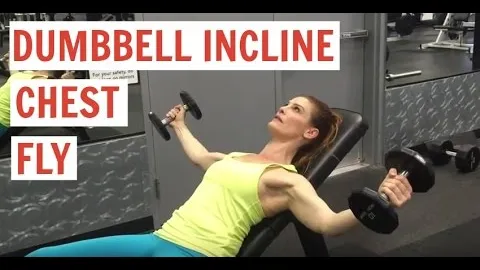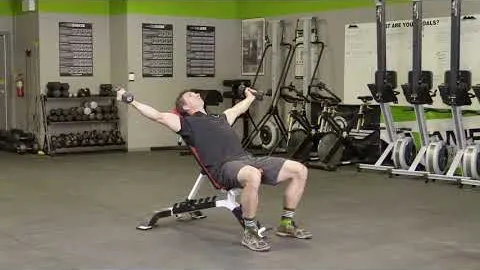

The incline chest fly exercise is one of the most effective ways to target and develop the muscles in your chest. By performing this exercise on an incline bench, you can specifically target your upper chest, leading to a more balanced and defined physique. In this article, we will provide a comprehensive guide on how to properly perform the incline chest fly exercise, its benefits, and variations to keep your workouts challenging and exciting.
Muscle Development: The incline chest fly primarily targets the pectoralis major muscles, which are responsible for the majority of chest development. By incorporating incline chest fly exercises into your routine, you can specifically target the upper chest muscles, leading to a more balanced and proportionate chest.
Increased Strength: As with any resistance exercise, the incline chest fly can help increase your overall strength. By challenging your muscles through a full range of motion, you can stimulate growth and improve your overall upper body strength.
Improved Stability: Incline chest fly exercises require stability and control, not only in your chest muscles but also in your shoulders and core. By regularly performing this exercise, you can improve your stability and posture, reducing the risk of injuries and enhancing your overall athletic performance.
Set Up: Start by adjusting an incline bench to a 30-45 degree angle. Lie back on the bench with a dumbbell in each hand, palms facing each other. Keep your feet flat on the ground, firmly planted for stability.
Engage Your Core: Before you begin the exercise, engage your core by tightening your abdominal muscles. This will help stabilize your body throughout the movement.
Begin the Movement: With your arms extended above your chest and a slight bend in your elbows, inhale and slowly lower the dumbbells out to the side in a wide arc motion. Lower the dumbbells until you feel a stretch in your chest muscles, being careful not to go too low to avoid shoulder strain.
Contract Your Chest: Exhale and slowly bring the dumbbells back to the starting position while squeezing your chest muscles. Focus on using your chest muscles to control the movement, rather than relying on your shoulders or arms.
Maintain Proper Form: Throughout the exercise, ensure that your back and head remain flat on the bench, and your elbows are slightly bent. Avoid locking your elbows as this can strain the joint.
Controlled Repetitions: Perform the exercise for the desired number of repetitions, typically 10-12 for hypertrophy or 6-8 for strength. Control the movement throughout the entire range of motion, maintaining a slow and controlled tempo.
Breathing: Inhale as you lower the dumbbells and exhale as you bring them back to the starting position. This controlled breathing pattern will help regulate your movements and enhance your stability.
Alternating Chest Fly: Instead of performing the exercise with both arms simultaneously, try alternating the movement. Lift one arm while lowering the other, alternating sides with each repetition. This variation provides added stability challenges and can help correct muscle imbalances.
Resistance Band Chest Fly: If you don't have access to dumbbells or a bench, you can perform the incline chest fly exercise using resistance bands. Anchor the bands to a stable point behind you, grasp the handles, and replicate the same movement pattern as you would with dumbbells.
Machine Chest Fly: Utilize the machine chest fly if you are looking for a more guided and supported movement. The machine provides additional stability while targeting the upper chest muscles effectively.
Cable Chest Fly: Using a cable machine with adjustable pulleys, attach D-handles at chest height. Stand in a split stance and perform the chest fly motion by pulling the handles together in front of you.
Always start with a light weight and gradually increase the resistance as you become more comfortable and confident with the movement. Proper form and technique are crucial to avoid injuries.
If you have any shoulder or chest injuries, it is recommended to consult with a healthcare professional or a certified personal trainer before performing the incline chest fly exercise. They can provide modifications or alternative exercises that suit your needs.
Listen to your body and do not push through any pain or discomfort. If you experience sharp or intense pain, stop the exercise immediately and seek medical attention if necessary.
Warm-up your chest, shoulders, and arms before performing the incline chest fly exercise to increase blood flow and reduce the risk of injury.
Incorporate the incline chest fly exercise into a larger, well-rounded workout routine that includes exercises targeting all major muscle groups. This will help maintain muscle balance and overall strength.
The incline chest fly exercise is a fantastic way to target and develop your upper chest muscles effectively. By incorporating this exercise into your workout routine, you can achieve a more balanced and defined chest, increase overall strength, and improve stability. Remember to practice proper form, start with lighter weights, and gradually increase the resistance as you progress. As with any exercise, it is essential to listen to your body and prioritize safety. Now, go and incorporate the incline chest fly into your workouts to maximize your chest gains!
If you're looking for a gym, fitness club or yoga studio, you've come to the right place.
You can find information about gyms in your area. Browse catalog of gyms and find gyms with classes which are you looking for.
On gym page you can find simple information like address, phone or website. You can find list of available classes. You can check availability of personal training or small group classes. On place page you can also see information about open hours.
You can find gyms near you with amenities, courts, studios and equipments.
Use our map to find gym at your city or district.
In Gym Navigator you can find list of exercises with movies for many body parts.
You can browse exercises catalog and find exercises the best of you.
You can also find exercises grouped into workout plans, which you can use to improve you body. Each routine show you exercises one by one and give you possibility to count you progress and count down rest time.